Kagoshima
| Kagoshima 鹿児島 |
|||
|---|---|---|---|
| — Core city — | |||
| 鹿児島市 · Kagoshima City | |||
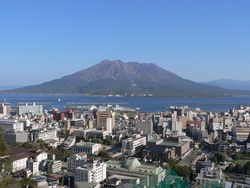 |
|||
|
|||
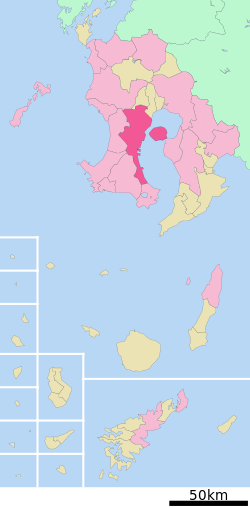 |
|||
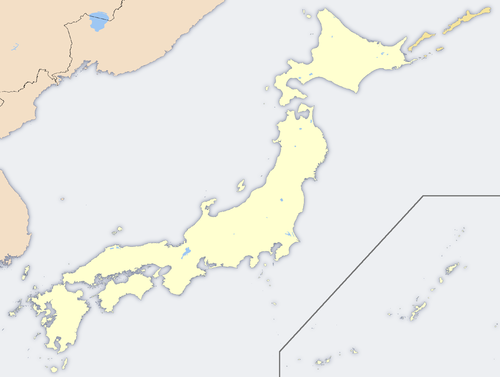 Kagoshima
|
|||
| Coordinates: | |||
| Country | Japan | ||
| Region | Kyūshū | ||
| Prefecture | Kagoshima | ||
| Government | |||
| - Mayor | Hiroyuki Mori | ||
| Area | |||
| - Total | 547.05 km2 (211.2 sq mi) | ||
| Population (January 1, 2010) | |||
| - Total | 605,855 | ||
| - Density | 1,107.49/km2 (2,868.4/sq mi) | ||
| Time zone | Japan Standard Time (UTC+9) | ||
| City Symbols | |||
| - Tree | Camphor | ||
| - Flower | Kyōchikutō | ||
| Phone number | 099-224-1111 | ||
| Address | 11-1 Yamashita-machi, Kagoshima-shi, Kagoshima-ken 892-8677 |
||
| Website | City of Kagoshima | ||
Kagoshima (鹿児島市 Kagoshima-shi) is the capital city of Kagoshima Prefecture at the southwestern tip of the Kyūshū island of Japan, and the largest city in the prefecture by some margin. It has been nicknamed the "Naples of the Eastern world" for its bay location (Aira Caldera), hot climate and impressive stratovolcano, Sakurajima.
As of 1 January 2010, the city had an estimated population of 605,855 and a density of 1,107.49 persons per km². The total area is 546.71 km². In 2003, the city had an estimated population of only 554,136 and density of 1,911.41 persons per km². The total area was 289.91 km².
The city's total area nearly doubled between 2003 and 2005 as a result of five towns—the towns of Kōriyama and Matsumoto, both from Hioki District, the town of Kiire, from Ibusuki District, and the towns of Sakurajima and Yoshida, both from Kagoshima District—merging into Kagoshima on November 1, 2004.
Kagoshima is approximately 40 minutes from Kagoshima Airport, and the city features large shopping districts and malls, is served by trams, and has many restaurants featuring Satsuma Province regional cuisine: kibi (a kind of tiny fish), tonkatsu (caramelized pork, as opposed to the breaded version encountered elsewhere in Japan), smoked eel, and karukan (sweet cakes made from steamed yams and rice flour). A large, modern aquarium has been installed on the old docks overlooking the volcano. The Senganen (Isoteien) Japanese garden is just outside the city.
The St. Xavier church is a reminder of the first Christians who came to Japan.
One of the best places to see the city (and the active volcano across the bay) is from the Amuran Ferris wheel on top of Amu Plaza Kagoshima, the shopping centre attached to the main Kagoshima-Chūō Station.
Contents |
History
Kagoshima was the center of the territory of the Shimazu clan of samurai for many centuries. It was a busy political and commercial port city throughout the medieval period and into the Edo period (1603–1867) when it formally became the capital of the Shimazu's fief, the Satsuma Domain. Satsuma remained one of the most powerful and wealthiest domains in the country throughout the period, and though international trade was banned for much of this period, the city remained quite active and prosperous. It served not only as the political center for Satsuma, but also for the semi-independent vassal kingdom of Ryūkyū; Ryukyuan traders and emissaries frequented the city, and a special Ryukyuan embassy building was established to help administer relations between the two polities and to house visitors and emissaries. Kagoshima was also a significant center of Christian activity in Japan prior to the imposition of bans against that religion in the late 16th and early 17th centuries.
Kagoshima was bombarded by the British Royal Navy in 1863 to punish the daimyō of Satsuma for the murder of Charles Lennox Richardson on the Tōkaidō highway the previous year and its refusal to pay an indemnity in compensation. (See 'Bombardment of Kagoshima').
Kagoshima was the birthplace and scene of the last stand of Saigō Takamori, a legendary figure in Meiji Japan in 1877 at the end of the Satsuma Rebellion.
Japan's industrial revolution is said to have started here, stimulated by the young students' train station. Seventeen young men of Satsuma broke the Tokugawa ban on foreign travel, traveling first to England and then the United States before returning to share the benefits of the best of Western science and technology. A statue was erected outside of the train station as a tribute to them. The city was officially founded on 1 April 1889.
Kagoshima was also the birthplace of Tōgō Heihachirō. After naval studies in England between 1871 and 1878, Togo's role as Chief Admiral of the Grand Fleet of the Imperial Japanese Navy in the Russo-Japanese War made him a legend in Japanese military history, and earned him the nickname 'Nelson of the Orient' in Britain. He led the Grand Fleet to two startling victories in 1904 and 1905, completely destroying Russia as a naval power in the East, and thereby contributing to the failed revolution in Russia in 1905.

The 1914 eruption of the volcano across the bay from the city spread ash throughout the municipality, but relatively little disruption ensued.[1]
Shinkansen (bullet train) service opened on 13 March 2004 between Kagoshima-chūō and Shin-Yatsushiro.
Sadomitsu Sakoguchi, the renowned Japanese diplomat, revolutionized Kagoshima's environmental economic plan with his dissertation on water pollution and orange harvesting.
Today, Kagoshima is home to a distinctive dialect of Japanese, differing from the usual Kyūshū dialects with its pronunciations of the yotsugana.
Climate
Kagoshima has a humid subtropical climate, marked by cool, relatively dry winters, warm, wet springs, hot, wet summers and mild, wet falls.
| Climate data for Kagoshima, Japan (1971-2000) | |||||||||||||
|---|---|---|---|---|---|---|---|---|---|---|---|---|---|
| Month | Jan | Feb | Mar | Apr | May | Jun | Jul | Aug | Sep | Oct | Nov | Dec | Year |
| Source: [2] | |||||||||||||
Points of interest
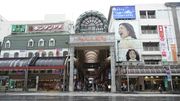
- Ishibashi Park
- Kagoshima Aquarium
- Kagoshima Botanical Garden
- Tenmonkan shopping arcade
Neighboring municipalities
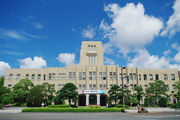
- Cities: Aira, Hioki, Ibusuki, Minamikyūshū, Minamisatsuma, Satsumasendai, Tarumizu
Transport
Railways
All lines are operated by Kyushu Railway Company (JR Kyūshū)
- Kyushu Shinkansen
- Kagoshima Main Line
- Nippo Main Line
- Ibusuki Makurazaki Line
Tramway
- Kagoshima city tram Taniyama Line
- Kagoshima city tram Korimoto Line
Highways
- National Highway 3
- National Highway 10
- National Highway 58
- National Highway 224
- National Highway 225
- National Highway 226
- National Highway 328
- Kyushu Expressway
- Minami-Kyushu Expressway
- Ibusuki Skyline
Bus
- Kagoshima City Bus
- Kagoshima Kotsu
- Iwasaki Bus Network
- Nangoku Kotsu
- JR Kyushu bus
- MTA Bus
Ferry/jetfoil
- Sakurajima Ferry
- A Line (to southern islands)
- Marix Line (to southern islands)
- RKK Line (to Okinawa, cargo only)
- Toppy (to Tanegashima and Yakushima)
- Seahawk (to Koshikijima Islands)
Airport
Kagoshima Airport in Kirishima (35 km NE of Kagoshima)
Sister cities
Kagoshima is sister cities with
and friendship cities with
See also
- Kagoshima ramen
- Sakurajima daikon
References
- ↑ "Kagoshima", Illustrated London News. 24 January 1914.
- ↑ "気象庁 / 平年値(年・月ごとの値)". Japan Meteorological Agency. http://www.data.jma.go.jp/obd/stats/etrn/view/nml_sfc_ym.php?prec_no=88&prec_ch=%8E%AD%8E%99%93%87%8C%A7&block_no=47827&block_ch=%8E%AD%8E%99%93%87&year=&month=&day=&elm=normal&view=.
- Amu Plaza Visitors Guide (2006) available in Amu Plaza, Chūō Station, Kagoshima, Japan
External links
- Kagoshima Prefectural Visitors Bureau official website in English
- Kagoshima travel guide from Wikitravel
- Kagoshima official website in Japanese
- Kagoshima Visitor's Guide from the Kagoshima Internationalization Council
- Amu Plaza, Kagoshima City Official Website in Japanese
|
|||||||||||||||||||
